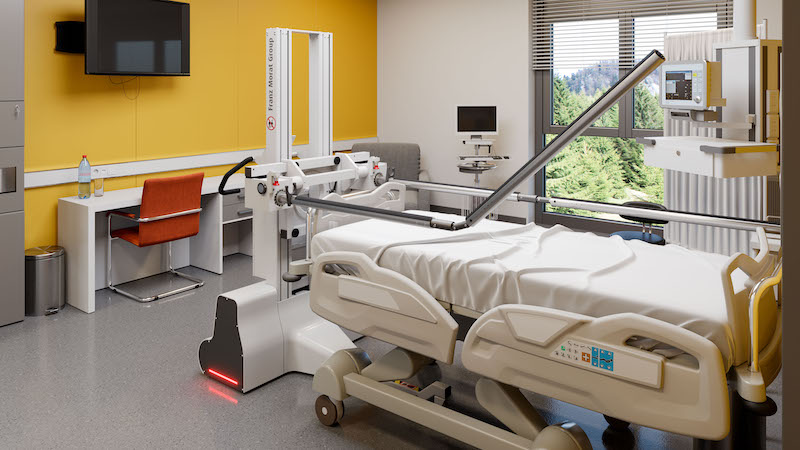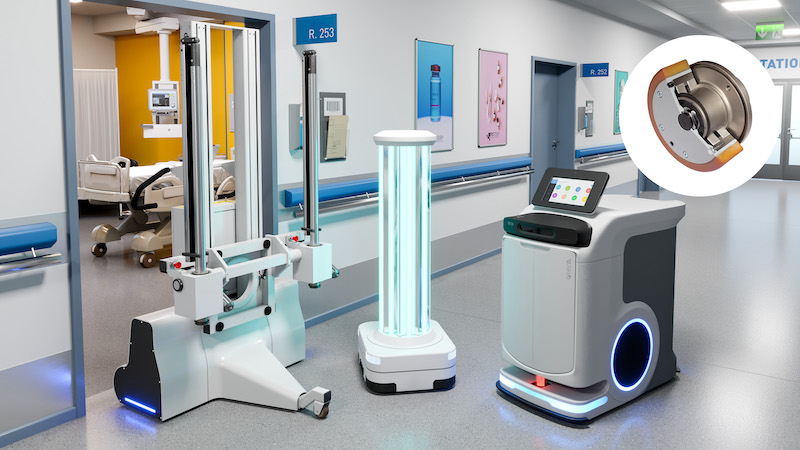
Franz Morat unveils innovative system that comfortably rotates and turns bedridden patients
For bedridden individuals, everything revolves around the correct resting position in the bed. The position must be adjusted to match each individual patient and their physical condition.
This means the patient’s position in the bed must be changed regularly to take pressure off of areas of the patient’s body and to prevent pressure sores. The goal is to make life in bed as pleasant as possible for the person in need of care.
Turning and repositioning bedridden individuals is a physically challenging procedure for caregiving staff. It is usually performed multiple times per day by a team of two or three caregivers and it requires a lot of time.
The procedure often involves equipment such as lifting or sliding mats, mobilization belts or patient lifts. Care must be taken to ensure that the bedridden person is moved carefully. Pulling or straining may result in injuries to the skin.
The Covid-19 pandemic has caused another significant increase in the amount of nursing and caregiving required for patients in intensive care. To treat artificially ventilated patients, it is recommended that they be turned into the prone position regularly to get more oxygen into the bloodstream.

“We came up with the idea for our system for repositioning bedridden persons after seeing the overfilled intensive care units on television last spring,” says Holger Kuster, who leads the development and design departments at Framo Morat.
Kuster is in charge of innovation management at the company, which is based in the High Black Forest region of Germany and specializes in drive technology.
One year and countless iterative stages later, Franz Morat Group is now presenting a new product innovation that is designed to make day-to-day work easier for caregivers while also making the repositioning more comfortable for the patient.
“When you use this system, it only takes one caregiver to reposition the patient and the process can be done in a way that is easier on the patient’s body,” says Kuster.
In addition, it is easier for the caregiver to interact with the patient and attend to the patient’s needs during the repositioning process. As a result, bedridden persons will feel safer, while ensuring comfortable and dignified treatment at the same time.
Compact system for versatile use on a variety of beds
It only takes a few steps to get the system up and running. The system can be used with a wide variety of hospital-style beds. Once the system has been positioned at the foot of the bed and the supporting device is extended, the winding shafts are extended and positioned parallel to the edges of the bed.
A loop-and-hook fastening system is used to attach a highly tear-resistant special bedsheet to the winding shafts. Rotating the winding shafts in the opposite direction securely fastens the bedsheet and the patient is lifted.
The standard version of the system was designed to have a load capacity of up to 120 kg body weight per patient. Kuster says that it is possible to scale the system for higher load capacities.
Thanks to the intuitive operation, predefined positions allow the patient to be repositioned comfortably to the 30° position, which is often recommended to prevent pressure sores.
To achieve this, the turning mechanism has a tilting feature that is used to position the winding shafts at different heights. This makes patient repositioning very gentle and easy on the patient’s body.
In addition, the 135° prone position can be selected to ventilate the dorsal pulmonary areas or in the event of dorsal injuries. Even a 180° turn, such as in a monitored intensive care unit, can be executed within a few seconds by significantly fewer staff.
“A considerable advantage is the units flexibility and compactness,” says Kuster.
The system was designed to fit narrow hallways and patient rooms with limited available space. In the transport position, when the winding shafts are collapsed and the supporting device is retracted, the dimensions are 2.00 m high, 1.00 m wide and 0.85 m long.
For home care, there is an option to install the repositioning device in a fixed location without the chassis.
The system also proves its worth economically when used in clinics or care facilities. The interface using the bedsheet ensures compatibility with a variety of beds. As a result, each facility or ward requires only one system, which can optionally be set up as an autonomous unit.
In this case, it is possible to navigate the unit as needed to the desired area of use at the touch of a button. The chassis of this “AGV”, as it is often called, is based on wheel hub drives from the Framo Morat modular gearbox, which are used in mobile disinfection robots, vehicles for transporting medications and other applications.
A useful additional feature of the repositioning system is the convenient option for weighing bedridden individuals.
By attaching weighing cells to the ground contact wheels, the weight of the patient can be reliably measured without having to reposition this patient onto a chair scale or a mobile elevator unit with a weighing function.
When developing the system, the Franz Morat Group innovation team was able to draw upon its many years of experience as a supplier and development partner of renowned medical technology companies and use this experience to its advantage.
The company is based in Eisenbach, Germany and has a long and rich history. Its product portfolio includes high-precision gear components for patient transport stretchers, helical worm gears for C-arm machines and completely customer-specific drive systems for operating tables or radiological equipment.
“After starting the project in May 2020, just three months later we were able to provide evidence of functionality by giving a demonstration using an early prototype demo device based on a forklift,” says Kuster.
“Then various concepts for winding the bedsheet were incorporated into the further development of the turning mechanism. At the same time, a suitable chassis was obtained and then combined with the turning mechanism in early 2021.”
In the center of the turning mechanism, there is a two-stage worm gear based on the standard worm gear sets from the Framo Morat product line.
By manufacturing more than 1 million gear sets per year, Framo Morat is one of the market leaders in this sector. The force is transferred directly to the winding shaft via the second gear stage.
Using a worm gear helps to account for the safety aspect because it provides the advantage of a self-locking effect when rotating the patient while they are in the air. The mechanism ensures that, in the event of a malfunction such as a power outage, the system stays locked in its current position and the bedsheet does not unwind from the winding shaft.
After successful field tests, the system for patient repositioning is ready to enter the market very soon. Framo Morat Group is currently looking for a partner with experience in medical technology.
